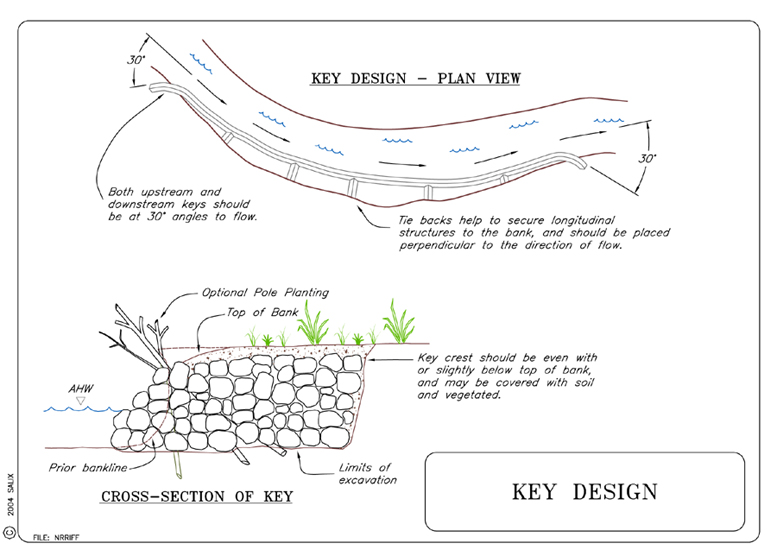| THE KEY TO STABILITY
IS THE KEY |
 |
Introduction
This topic deals with bank and flank keys. Toe scour keys are also required for many techniques, and those should be designed with the depth of anticipated scour in mind. Some excellent resources for determining scour depths are:
CHANLPRO1, Maynord, S., Hebler, M., and Knight, S. (1998). User’s manual for CHANLPRO, PC program for channel protection design, Technical Report CHL-98-20, U.S. Army Engineer Waterways Experiment Station, Vicksburg, MS. (pdf)
Richardson, E.V., & Davis, S. R. (2001) Evaluating scour at bridges: Hydraulic Engineering Circular No. 18, Fourth Edition, FHWA NHI 01-001, Federal Highway Administration, Washington, D.C. http://199.79.179.19/OLPFiles/FHWA/010590.pdf retrieved November 2004
Richardson, E.V., Simons, D.B., & Lagasse, P.F., (2001) River Engineering for Highway Encroachments, FHWA NHI 01-004, HDS-6 (Hydraulic Design Series Number 6), Federal Highway Administration (Office of Bridge Technology), Washington D.C., and the National Highway Institute, Arlington VA, December 2001. http://199.79.179.19/OLPFiles/FHWA/010589.pdf retrieved November 2004.
Protection of flanks
Many streambank protection projects fail at the upstream or
downstream end. Local flow acceleration or 'expansion' at the downstream end
of the protection project often leads to local scour that progressively undercuts
the protection and eats its way upstream. At the upstream end, erosion associated
with impinging flow sometimes results in flow above or behind the protective
measures and eventual failure.
Keys consist of rock riprap or other heavy granular material buried in deep
trenches dug at
30° angles (not perpendicular) to flow (see Figure 1). Most continuous
techniques that fail do so at the upstream or downstream ends, and the failure
is usually a result of improperly aligned keys. Keys oriented perpendicular to
flow result in accelerated erosion, expansion and 'eddies' at the downstream
end. Always orient keys at a 30° angle to the direction of flow (D. Derrick,
personal communication, 2002).
All bank protection systems must be keyed into the bank. Never let the stream
scour deeper than, or flank (get behind), bank protection works. Key dimensions
should be sized to the stream and stream flows. The volume of the stone per
unit length within the key should be greater than or equal to the volume of
stone per unit length contained within the river training structure.
Design considerations include:
Soil types.
Flow velocities.
Flood crests, durations and recurrence intervals.
Active failure areas.
Vegetation.
Height of bank.
Exposed key rocks in banks can be angled to help redirect flow.
Crests of keys should be flush (even) with the bank, as this will decrease turbulence and chance of scour (see Figure 1). If key rock is exposed on the surface of the bank, it can be angled (using Bendway Weir theory, flow will be redirected perpendicular to the axis of the key) to help redirect flow on the bank back toward the stream.
Keys at the upstream and downstream ends of continuous longitudinal features should not be at a 90° angle to the feature, but at a 30° angle.
Definitions:
1. Key: Consists of rock, stone, or other immovable
material buried in the bank in deep trenches at the upstream and downstream
ends of the structure.
2. Tie backs: Periodic keys that ‘tie’ the
structure into the bank; used most frequently with indirect, continuous methods
(eg., Longitudinal Stone Toe).
3. Key roots: Extensions of keys or tie backs that
extend into the overbank areas.

Figure 1. Plan and Cross-section views of Keys
Types of Keys
1 Note: Netscape users may need to access this file directly from the folder on the CD. (HTML > WorksCited > CHANLPRO >CHANLPRO.exe)